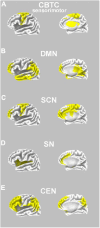Psychedelics in developmental stuttering to modulate brain functioning: a new therapeutic perspective?
- PMID: 38962146
- PMCID: PMC11221540
- DOI: 10.3389/fnhum.2024.1402549
Psychedelics in developmental stuttering to modulate brain functioning: a new therapeutic perspective?
Abstract
Developmental stuttering (DS) is a neurodevelopmental speech-motor disorder characterized by symptoms such as blocks, repetitions, and prolongations. Persistent DS often has a significant negative impact on quality of life, and interventions for it have limited efficacy. Herein, we briefly review existing research on the neurophysiological underpinnings of DS -specifically, brain metabolic and default mode/social-cognitive networks (DMN/SCN) anomalies- arguing that psychedelic compounds might be considered and investigated (e.g., in randomized clinical trials) for treatment of DS. The neural background of DS is likely to be heterogeneous, and some contribution from genetically determinants of metabolic deficiencies in the basal ganglia and speech-motor cortical regions are thought to play a role in appearance of DS symptoms, which possibly results in a cascade of events contributing to impairments in speech-motor execution. In persistent DS, the difficulties of speech are often linked to a series of associated aspects such as social anxiety and social avoidance. In this context, the SCN and DMN (also influencing a series of fronto-parietal, somato-motor, and attentional networks) may have a role in worsening dysfluencies. Interestingly, brain metabolism and SCN/DMN connectivity can be modified by psychedelics, which have been shown to improve clinical evidence of some psychiatric conditions (e.g., depression, post-traumatic stress disorder, etc.) associated with psychological constructs such as rumination and social anxiety, which also tend to be present in persistent DS. To date, while there have been no controlled trials on the effects of psychedelics in DS, anecdotal evidence suggests that these agents may have beneficial effects on stuttering and its associated characteristics. We suggest that psychedelics warrant investigation in DS.
Keywords: default mode network; developmental stuttering; neuropsychopharmacology; psychedelic compounds; social-cognitive networks.
Copyright © 2024 Pasculli, Busan, Jackson, Alm, De Gregorio, Maguire, Goodwin, Gobbi, Erritzoe and Carhart-Harris.
Conflict of interest statement
GM reported a conflict of receiving research support and scientific consulting fees from Noema. GaG received a research grant from Diamond Therapeutics, Toronto (ON), Canada. DD was a consultant for Diamond Therapeutics, Toronto (ON), Canada. GaG and DD were inventors of a patent on the use of psychedelics. GuG was Chief Medical Officer at Compass pathways, holds shares and options in Compass pathways and has served as consultant, advisor or CME speaker in the last 3 years for Beckley Psytech, Boehringer Ingelheim, Clerkenwell Health, Compass pathways, Evapharma, Janssen, Lundbeck, Medscape, Novartis, Ocean Neuroscience, P1Vital, Sage, Servier, and Takeda. DE was a paid advisor for Aya Biosciences, Clerkenwell Health, and Mindstate Design Lab. RC-H reported receiving consulting fees from COMPASS Pathways, Entheon Biomedical, Mydecine, Synthesis Institute, Tryp Therapeutics, and Usona Institute. The remaining authors declare that the research was conducted in the absence of any commercial or financial relationships that could be construed as a potential conflict of interest.
Figures

Similar articles
-
Developmental stuttering and the role of the supplementary motor cortex.J Fluency Disord. 2020 Jun;64:105763. doi: 10.1016/j.jfludis.2020.105763. Epub 2020 Apr 20. J Fluency Disord. 2020. PMID: 32361030 Review.
-
Speech Fluency Improvement in Developmental Stuttering Using Non-invasive Brain Stimulation: Insights From Available Evidence.Front Hum Neurosci. 2021 Aug 11;15:662016. doi: 10.3389/fnhum.2021.662016. eCollection 2021. Front Hum Neurosci. 2021. PMID: 34456692 Free PMC article. Review.
-
Transcranial magnetic stimulation in developmental stuttering: Relations with previous neurophysiological research and future perspectives.Clin Neurophysiol. 2017 Jun;128(6):952-964. doi: 10.1016/j.clinph.2017.03.039. Epub 2017 Apr 3. Clin Neurophysiol. 2017. PMID: 28431323 Review.
-
White matter tract strength correlates with therapy outcome in persistent developmental stuttering.Hum Brain Mapp. 2022 Aug 1;43(11):3357-3374. doi: 10.1002/hbm.25853. Epub 2022 Apr 12. Hum Brain Mapp. 2022. PMID: 35415866 Free PMC article.
-
The relationship between the default mode network and the theory of mind network as revealed by psychedelics - A meta-analysis.Neurosci Biobehav Rev. 2023 Sep;152:105325. doi: 10.1016/j.neubiorev.2023.105325. Epub 2023 Jul 17. Neurosci Biobehav Rev. 2023. PMID: 37467907 Review.
Cited by
-
The role of anticipation and neuroticism in developmental stuttering.Front Psychol. 2025 May 21;16:1576681. doi: 10.3389/fpsyg.2025.1576681. eCollection 2025. Front Psychol. 2025. PMID: 40470016 Free PMC article.

